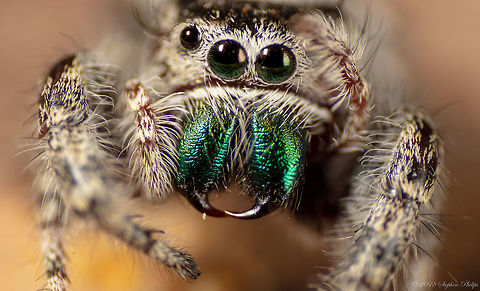
Appearance
The adult female bold jumper ranges from 8-15 mm in body length. The males are smaller and adults range from 6-13 mm in body length. They are typically black with an ovoid abdomen and round cephalothorax. The presence of a distinct white triangle in the center of the back with two smaller spots below it is often used to distinguish this species. On the upper abdomen, there is a lateral white band. Bold jumpers are often recognized by their powerful legs that they use to jump. The legs and pedipalp have white banding with fringes that are more prominent in males. In females, the fourth pair of legs are typically the longest while in males the first pair of legs are the longest. The chelicerae are iridescent green. The adult males chelicerae and markings are much more striking than the females and they have tufts of hair over their eyes. In spiderlings, markings are usually orange and turn white as the spider matures. Bold jumpers may also vary in size and coloration amongst different populations.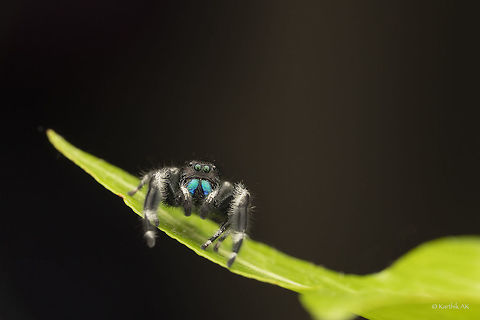
Naming
"Phiddipus audax" are commonly referred to as "bold jumping spiders" or "bold jumpers". The species name, "audax," is a Latin adjective meaning "audacious" or "bold". This name was first used to describe the species by French arachnologist Nicholas Marcellus Hentz, who described the spider as being, "very bold, often jumping on the hand which threatens it". Bold jumpers belongs to the jumping spider family, "Salticidae", which is derived from the Latin word "saltare" meaning "to jump".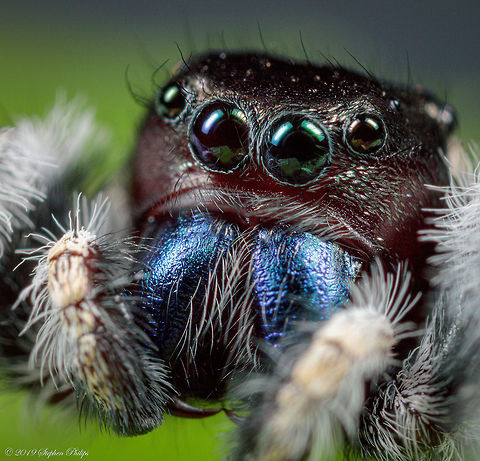
Distribution
Bold jumping spiders are native to North America. They are widespread throughout the United States, southern Canada, and northern Mexico. It is believed they were introduced to the arid regions of the southwest United States, surviving in areas where irrigation is practiced. They were also introduced to Hawaii, Nicobar Islands, Azores, and the Netherlands.Bold jumpers prefer temperate climates and can be found in a variety of terrestrial habitats including grasslands, chaparrals, open woodlands, and agricultural fields The bold jumper is one of the most commonly occurring spider species within its range and can be found living in close proximity to humans. They are frequently seen in gardens, and insides homes, barns, and garages. Jumping spiders require daylight to see and are thus more likely to be observed during the day. At night, bold jumpers can be found sheltering in sac-like silk retreats near their hunting grounds. They spin these retreats in concealed areas, frequently on vegetation and under stones and bark. These retreats help protect the spider and are often used repeatedly. Similar retreats are utilized in overwintering individuals. Bold jumpers are one of the most abundant spiders in agricultural crops and hunt many crop pests. In parts of it southern range, they can be found in grassy areas near water.
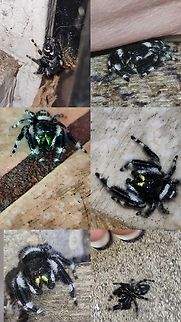
Behavior
Bold jumpers will quickly flee from animals that are too large to eat, jumping down and away or hiding in small crevices. At night they hide in a crevice or small cavity and make a silk retreat to avoid predators that hunt by touch. Bold jumpers are shy spiders that retreat from humans when approached. If handled, they generally do not bite. These characteristics make them appear to have a great deal of curiosity and personality. Like most jumping spiders, bold jumpers hunt alone during the day.Further information: :Spider behaviorAbout 10 days after oviposition, spiderlings hatch within the egg-sac. After hatching, they complete their first molt within the egg-sac and do not emerge for another 10-14 days. They emerge as second instars that are free-living and capable of hunting. After emerging, spiderlings often disperse through ballooning. Bold jumpers continue to mature through 6-7 more instars. Every instar, with the exception of the first, completes its molt within a molting web. They enclose themselves in this web to shed their exoskeleton. After each molt, they emerge larger. Females usually require one more instar than males and reach maturity a few weeks later. This is likely because they are larger and need more time to develop. On average, bold jumpers take about 9 months from oviposition to reach sexual maturity.
In the northern part of its range, bold jumpers overwinter as immatures. In preparation, these spiders envelop themselves in sac-like silk shelters hidden underneath rocks and bark. These shelters help conceal and protect the spider. As temperatures drop, spiders enter a state of dormancy called diapause, during which development is halted. Spiders emerge in the spring and complete their final molts. They are typically ready to mate by late spring or early summer. In a laboratory study, the lifespan of bold jumpers was a little over a year with females living a couple months longer than males.
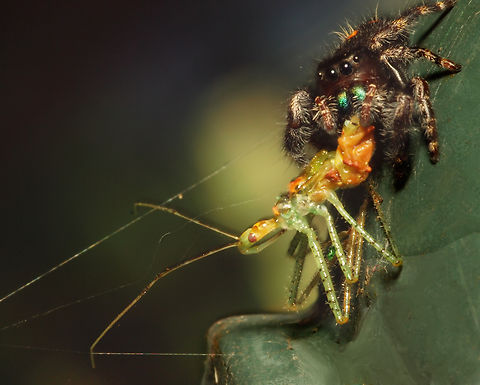
Habitat
Bold jumping spiders are native to North America. They are widespread throughout the United States, southern Canada, and northern Mexico. It is believed they were introduced to the arid regions of the southwest United States, surviving in areas where irrigation is practiced. They were also introduced to Hawaii, Nicobar Islands, Azores, and the Netherlands.Bold jumpers prefer temperate climates and can be found in a variety of terrestrial habitats including grasslands, chaparrals, open woodlands, and agricultural fields The bold jumper is one of the most commonly occurring spider species within its range and can be found living in close proximity to humans. They are frequently seen in gardens, and insides homes, barns, and garages. Jumping spiders require daylight to see and are thus more likely to be observed during the day. At night, bold jumpers can be found sheltering in sac-like silk retreats near their hunting grounds. They spin these retreats in concealed areas, frequently on vegetation and under stones and bark. These retreats help protect the spider and are often used repeatedly. Similar retreats are utilized in overwintering individuals. Bold jumpers are one of the most abundant spiders in agricultural crops and hunt many crop pests. In parts of it southern range, they can be found in grassy areas near water.
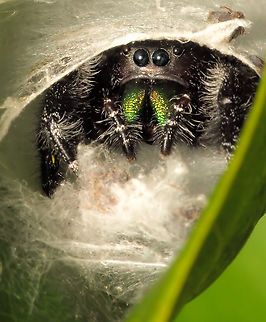
Reproduction
Further information: :Spider behavior and :Spider anatomyAfter completing their final molts, bold jumpers are fully developed and ready to mate. A male prepares for mating by constructing a small silk mat upon which he releases his sperm from his testes and then draws it into each of his two emboli. The male then begins to search for a female. Females emit pheromones in their draglines that males can detect through contact with chemoreceptors in their pedipalps. This provides the male with information about the females reproductive status and aids in his search.
Because males mature before females, they often encounter an immature female's nest when searching for a mate. In an attempt to increases his chances of mating, he will build a nest next to the female and wait until the females matures for an opportunity to mate. Upon encountering a sexually mature female, he begins a courtship display. In this display, he raises his front legs, then flicks his forelegs, and shakes his pedipalps while moving laterally in a zigzag path. He occasionally pauses in a pose with his legs still raised. The male continues his dance while slowly approaching the female. The female often raises her front legs defensively, sometimes attacking or killing the male. If she receives him, she will lower her legs and remain still, allowing him to mount her back. Facing her posterior, he then uses his legs to repeatedly rotate her in order to insert his emboli into her two epigynum, releasing his sperm. The average copulation event takes about one hour and 18 minutes but ranges anywhere from 14 minutes to two hours and 48 minutes for both northern and southern forms. Males will continue to mate with multiple females but females typically only mate once per reproductive event, from which she can lay up to 6 clutches of eggs before needing to mate again. Reproductive periods are typically in late spring and early summer with the majority of eggs being laid in June and July. In warmer regions, reproduction is extended or continuous.
After mating, a female bold jumper prepares a nest to deposit her eggs. She builds these nest in hidden areas, usually under rocks, bark, and leaves. She starts by first weaving a thin sheet of silk. In the center of this sheet, she begins constructing the egg-sac by weaving a dense bed. Next, she deposits her eggs in the center, containing anywhere from 30-170 eggs over a period of 1.5-3 hours. After she finishes laying, she covers them creating a disk shaped egg-sac. She then weaves a cave like webbing over the sac where she will remain during incubation guarding the eggs and adding more silk periodically. She does not eat during this time period and will not leave the nest until the second instars emerge from the egg-sac a month later.
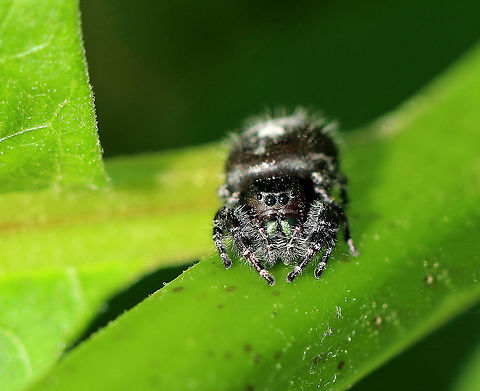
Food
Bold jumpers are solitary carnivores. They rely on their highly specialized eyesight to actively hunt and capture live prey. Because they rely on their eyesight, they are diurnal. They are often found hunting on fence posts and plants' leaves, stems, and branches. Bold jumpers prey on a variety of insects and non-insect terrestrial arthropods such as caterpillars, dragonflies, grasshoppers, and other spiders. As one of the most common spiders found in agricultural areas, they consume many crop pests including bollworms, boll weevils, spotted cucumber beetles, sorghum midges, fall webworms, cotton leaf worms, cotton fleahopper, tarnished plant bugs, stink bugs, lotus bugs, three-cornered alfalfa hoppers, and leafhoppers. For many of these species, bold jumpers feeds on both the larval and adult forms. The size of the prey is correlated with the size of the spider. Spiderlings feed on smaller prey than adults. Feeding habits also differ by sex. Females tend to spend more time feeding and consume more and larger prey than males. Alternative feeding behaviors include araneophagy, herbivory, indirect vertebrate blood feeding, myrmecophagy, nectivory, and prey stealing.When "Phidippus audax" finds its prey, it first orients itself so its anterior median eyes are facing the prey. It then stalks its prey, slowly approaching until it is within jumping distance. Once close enough, it crouches and releases a silk dragline that will tether the spider if it falls or misses its target. Next, it pounces with its legs raised. It grasps onto its prey with its forelegs while sinking its fangs into the prey, immobilizing it with its venom. Bold jumpers are able to distinguish between different types of prey and adjust their attack accordingly. They have been observed attacking loopers from the front and biting their head in order to avoid being stricken by them. Contrasting this, when attacking flies, they avoid attacking from the front in order to avoid alarming the fly and causing it to fly away. Although bold jumpers don't build webs of their own, they have been observed invading the webs of other spiders to steal freshly caught insects or attack the spiders themselves. Bold jumpers have extra-oral digestion and use their fangs to suck the liquid out their prey.

Predators
Species of spider wasps and thread-waisted wasps have been observed feeding on bold jumpers to their young. Additionally, lizards, dragonflies, birds, and other spider species are known predators of the bold jumping spider. At night, they hide from predators in silk retreats. During the day, they will hide from predators by hiding in crevices. Their secondary eyes are specialized in detecting "looming" objects and provide them a near 360° view, allowing them to quickly detect an approaching predator.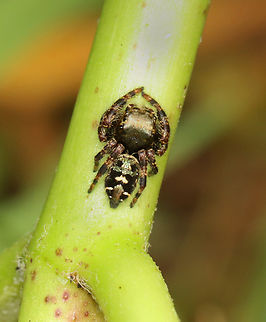
Evolution
The bold jumping spider is believed to have first been described in 1833 by French entomologist, Pierre-Hippolyte Lucas, who named the spider "Salticus variegatus". In 1845, Nicholas Marcellus Hentz published his work describing a species he called Attus audax. These types were believed to be the same species, but due to the loss of specimens there was much confusion about their identities. In 1846, Carl Ludwig Koch created the genus "Phidippus" in which "Phidippus variegatus" and "Phidippus audax" were considered separate species, with southern specimens regarded as "Phidippus variegatus" and northern specimens regarded as "Phidippus audax". However, the use of "Phidippus audax" was favored and further research concluded that they were the same species. The name "Salticus variegatus" has since been declared "nomen oblitum".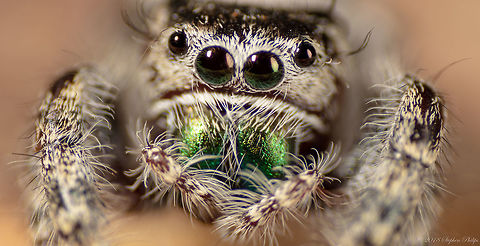
Cultural
On June 11 2021, New Hampshire Governor Chris Sununu signed the HB 318 bill designating "Phidippus audax" as the state spider. The designation came after a campaign by a class in Hollis, New Hampshire. Bold jumpers are currently very abundant and one of the most common spiders in the United States. As a major predator of crop pests, they have been studied to determine their impact on pest insect populations. In addition to eating pests, they also eat beneficial insects such as pollinators.References:
Some text fragments are auto parsed from Wikipedia.